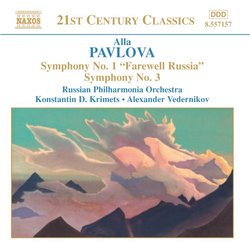Mantle of Sibelius
Clarion | 04/11/2006
(5 out of 5 stars)
"Pavlova's so-called First Symphony reminds me of academic piece written for a composition course. Enough about that.
Pavlova's Third Symphony is entirely a different matter. It is passionate music, evoking a visceral response in the listener. It is highly romantic, and is almost as if Sibelius's mantle has fallen on her.
In the first movement she prevents she presents a Bolero-like pulsating Spanish theme, and like Ravel's Bolero adds textures to textures. This alternates with long melodic lines, sustenuto. The orchestration is masterful. It is as if the first movement captured the carefree heart and joy of a country girl-very possibly Joan of Arc.
The second movement, largo assai, starts with cellos over pizzicato base. It is mournful, capturing with Russian pathos the sorrow and pain of the world. Has our country girl finally been touched by the pain of the world?
The third movement is haunting, wintry stillness. Is this the dark night of the soul?
The fourth movement is full of brass fanfare, swooping strings and tender violin solos. The joy in Spanish motives from the first movement return, but there also returns the wintry stillness. Has the country girl embraced both joy and sorrow, and now can go forth purposefully?
This is chromatically tonal, lyrical, and passionate music, with interesting harmonies and extended fortissimo passages. As an amateur musician, I'd love to have a chair in an orchestra to play this. It deserves a place next to the Sibelius Seventh and the Tchaikovsky Fourth. Yes, it is that good.
Is it, as another reviewer wrote, "waiting-room music"? Yes, but only in the waiting room to heaven.
"
Symphony Number 3 is fabulous
Ronald Linton | Denver, Colorado | 07/26/2005
(5 out of 5 stars)
"It isn't every day that a new piece of music touches me like this piece.I heard it on satelite radio the other day and I had to have it. The third symphony is one of the most beautiful symphonies I have ever heard.This is a delightful, inspiring work."
Pleasant Enough but Short on Substance and Variety
J Scott Morrison | Middlebury VT, USA | 12/16/2003
(2 out of 5 stars)
"A friend once described the wildly successful book, 'Bridges of Madison County,' as 'written for people who don't read books.' I would apply a similar assessment to the music on this disc. Alla Pavlova, a Russian emigrant now living in New York, has reportedly written four symphonies and this disc contains two of them. The First, subtitled 'Farewell Russia,' is actually a one-movement piece for eleven instruments, including an important part for piano who makes three cadenza-like contributions to the proceedings. The dynamic rarely rises above mezzo piano and there is a good deal of noodling and repetition. The composer, whose comments are quoted extensively in the booklet, says that it was composed in response to her returning to her native land after some years away. Frankly, all I am able to hear in the piece is a somewhat anemic kind of minimalism with occasional striking instrumental color. There is little that suggests an emotional response of any kind. I imagine that it would be best used as background music while one is paying attention to other things.Symphony No. 3, in four movements lasting almost forty minutes, also rarely raises its voice. But it does insist, again and again, on repeating the same things, mostly andante and mostly mezzo piano until, for this listener at least, it wears out its welcome. Further, the composer says, it was inspired by a statue of Joan of Arc on New York's Riverside Drive. That is as may be but I see little connection between Joan of Arc and the insistent but wan Latin rhythms of the first movement. Her statement, 'It is my hope that this music will provide support and inspiration to the listeners at difficult moments of their lives' is tendentious and just a little pompous. The melodies are simple, tonal, not terrible memorable even after being repeated seemingly ad infinitum. This is pleasant enough, particularly if you don't pay much attention, but if you do and have any knowledge of classical music at all, you begin to wonder what the point is. The performances are good, the instrumentalists quite competent, the recorded sound quite good. A shame they aren't matched by the music. This is waiting-room music.Scott Morrison"


 Track Listings (5) - Disc #1
Track Listings (5) - Disc #1